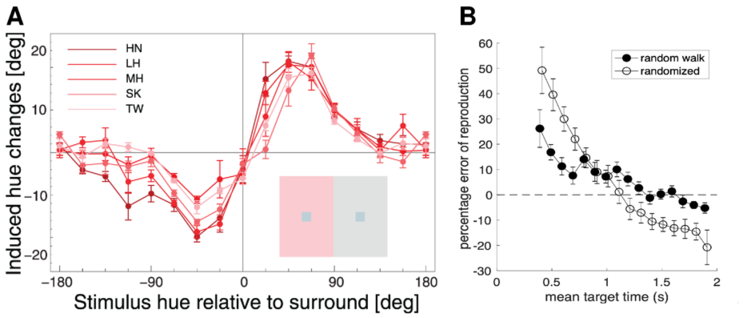TP Shi/Wachtler 1: Contextual Biases in space and time
PhD stundent Yannan Su:
"Our percept is susceptible to change when environment background or prior history varies. For example, subjective judgment of a color depends on the chromaticity of its surround (Kellner & Wachtler, 2016; Klauke & Wachtler, 2015); perceived orientation can be biased by what orientation you have seen previously (Fischer & Whitney, 2014; Schwartz, Hsu, & Dayan, 2007); and subjective duration is assimilated toward the mean of perceived durations (Shi, Church, & Meck, 2013). Influences of spatial or temporal context on percepts often exhibit a tilt curve function, showing bias that first increases as the contextual difference increases and decreases when the contextual difference become large enough (see Figure 1). By revisiting a classic perceptual bias - Vierordt’s law - we recently revealed that the contextual bias much depends on the sequence itself. The bias is related to large trial-by-trial variation in experimental design (Glasauer & Shi, 2018), which is unnatural and rarely exists in the real world but only in the laboratory. This poses an open question: to which degree do contextual biases depend on the statistics and dynamics of stimuli and their regularities in naturalistic environments?"

Figure 1. Context dependence of percepts. (A) Perceived hue depends on relative hue difference to surround (adapted from Klauke & Wachtler, 2015).
(B) Average time reproduction error depends on the sequence of target times (adapted from Glasauer & Shi, 2018).
In this tandem project, we aim to tackle this question by examining biases in spatial and temporal contexts. The project consists of three parts: In the first part of the project, we aim to identify contextual biases in the temporal domain, namely how time perception is influenced by properties of the stimulus sequence, by comparing different types of testing sequences (e.g., natural random-walk sequence vs arbitrary randomized sequence). In the second part of the project, we plan to investigate contextual biases in the spatial domain, particular in color perception, with different types of spatial structure (e.g., natural scene and objects vs arbitrary randomized scenes). This will enable to identify similarities between spatial and temporal biases. We have hypothesized that, given the natural spatio-temporal coupling imposed by eye movements in natural viewing, context-dependence in vision may constitute a predictive component of efficient saccadic remapping (Klauke & Wachtler, 2015). Therefore, in the third part we will examine how previously sampled scene statistics through eye movements influences perception, by investigating different types of spatio-temporal context (e.g., natural viewing statistics vs randomized stimulus sequences). We intend to use eye tracking methods (e.g., fixation duration, saccadic amplitude, scanpath) to determine viewing statistics and investigate saccade-dependent contextual modulation. In parallel, we will use EEG, fMRI methods to uncover underlying neural mechanisms of contextual dependence. Using statistical and mechanistic models, we will elucidate and describe common principles underlying spatial and temporal contextual biases in perception.
References
Fischer, J., & Whitney, D. (2014). Serial dependence in visual perception. Nature Neuroscience, 17(5), 738–743.
Glasauer, S., & Shi, Z. (2018). 150 years of research on Vierordt’s law - Fechner's fault? bioRxiv. https://doi.org/10.1101/450726
Kellner, C. J., & Wachtler, T. (2016). Stimulus size dependence of hue changes induced by chromatic surrounds. Journal of the Optical Society of America. A, Optics, Image Science, and Vision, 33(3), A267–A272.
Klauke, S., & Wachtler, T. (2015). “Tilt” in color space: Hue changes induced by chromatic surrounds. Journal of Vision, 15(13), 17. https://doi.org/10.1167/15.13.17
Schwartz, O., Hsu, A., & Dayan, P. (2007). Space and time in visual context. Nature Reviews. Neuroscience, 8(7), 522–535.
Shi, Z., Church, R. M., & Meck, W. H. (2013). Bayesian optimization of time perception. Trends in Cognitive Sciences, 1–9.
